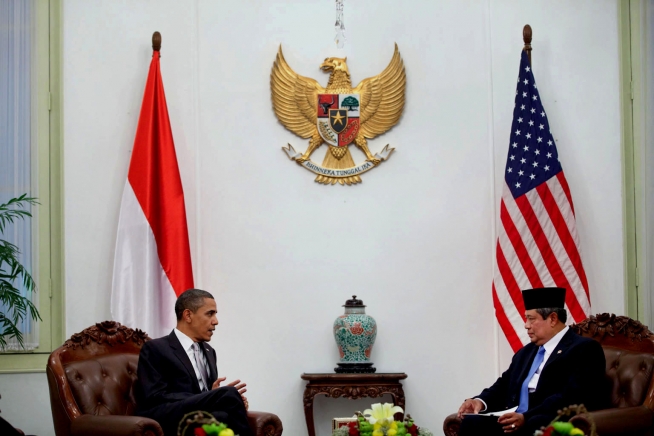 This week, I participated in the 39th meeting of the Australian Member Committee of the Council for Security Co-operation in the Asia-Pacific (Aus-CSCAP) in Darwin. This year’s theme was the US ‘rebalance’ and Southeast Asia, with a specific focus on the implications for Australia–Indonesia defence cooperation.
This week, I participated in the 39th meeting of the Australian Member Committee of the Council for Security Co-operation in the Asia-Pacific (Aus-CSCAP) in Darwin. This year’s theme was the US ‘rebalance’ and Southeast Asia, with a specific focus on the implications for Australia–Indonesia defence cooperation.
Comprising officials, academics and journalists from both countries, the discussions were open, frank and refreshing. For me, one of the key messages during the meeting was that Indonesia increasingly sees defence cooperation with the US as both a strategic and a tactical asset amid power shifts in Southeast Asia. My clear impression was that, if push comes to shove, Jakarta will side with Washington against Beijing’s attempt to establish a hegemonic position in Southeast Asia.
Much has been made of Indonesian concerns over the US ‘pivot’ announcement in November 2011 and the accompanying decision to rotate US Marine contingents through bases in northern Australia. However, as became very clear at the meeting, Jakarta’s criticism of the pivot was more for domestic consumption than reflecting serious strategic concerns about the Darwin deployment. In fact, Indonesian participants readily admitted that Jakarta very much welcomed the pivot for strategic and tactical reasons.
Strategically, for Indonesia the pivot serves as a reassurance against unwanted security developments in Southeast Asia, for example Chinese attempts to enforce its claims in the ‘nine-dashed line’. Recent incidents involving Indonesian maritime security vessels and illegal Chinese fishing boats operating within Indonesia’s Exclusive Economic Zone (EEZ), as discussed here by Scott Bentley on The Strategist, only add to Jakarta’s concerns that, even though Indonesia isn’t a claimant state in South China Sea territorial disputes, Beijing’s aspirations might eventually encroach on Indonesia’s maritime interests. Thus, behind closed doors some Indonesian analysts describe Beijing as a potential ‘military threat’ in the longer term.
In this context, the US pivot works for Indonesia, since policymakers clearly understand that the US isn’t asking them to ‘choose’ between Washington and Beijing. Rather, it’s a scalable ‘hedging’ strategy against China’s rise without infringing on Indonesia’s traditional ‘non-alignment’ policy. As well, Indonesian analysts note that Indonesia’s long-term strategic interests align much closer with those of the US, Australia and even Japan, which unlike China, share Indonesia’s interest in the status quo in Southeast Asia. These countries also recognise Jakarta’s emergence as a regional major power and a natural leader in ASEAN, while Indonesia increasingly regards China as attempting to ‘divide and conquer’ the organisation. Finally, it matters to Indonesia that these countries share universal democratic values as well as common ideas about international norms and behaviour. In short, there’s a distinct lack of ‘strategic confidence’ in China’s intentions.
In addition, the Indonesian military (Tentara Nasional Indonesia, TNI) regards increased US military presence in the region as a positive. Since it’s still too weak to defend Indonesia’s littoral approaches against a major military power, TNI welcomes America’s military (re-)engagement in Southeast Asia; recognising that this posture is still fairly limited and focused on rotational deployments, not permanent bases. TNI also appreciates the role the US military can play in supporting its very ambitious plans to become a major regional player over the next two decades or so. Washington isn’t only attractive as a supplier of sophisticated military platforms, such as the recent deal on the delivery of eight Boeing AH-64 Apache attack helicopters. The US also funded and put in place Indonesia’s Integrated Maritime Surveillance System (IMMS), which is located to cover the Malacca Strait, Sulawesi Sea and Moluccas Strait. The IMMS consists of 18 coastal surveillance stations, 11 ship-based radars, two regional command centres and two fleet command centres. The US also provided US$4.6 million to ensure sustainment until 2014. Finally, senior TNI leaders acknowledge that closer defence cooperation with the US will help to turn military platform acquisitions into actual military capabilities. Interaction with the US Marines in Darwin as part of the development of TNI’s amphibious capability is one such element.
All of this doesn’t mean that Indonesia is already actively ‘balancing’ against China. It’s still trying to ‘navigate in more turbulent waters’, as one participant put it, by cooperating with both the US and China. This includes the military domain, where for example Jakarta has reached an agreement with Beijing to locally produce the Chinese C-802 cruise missile which is fitted on the TNI’s large patrol craft. However, should China continue to push the strategic envelope in Southeast Asia, it’s very likely that Indonesia will not only push back but will also increase its strategic cooperation with the US.
This is predominantly good news for Australia. Strategically, it means that our American ally will become more involved in helping Indonesia to realise its regional power potential. A stronger Indonesia will provide Australia with greater strategic depth amid the uncertainties of power shifts in Asia. That said, it’s more important than ever for Australia to prepare for a future in which Indonesia is much stronger than has been the case previously, and is increasingly willing and able to pursue its own strategic interests.
Benjamin Schreer is a senior analyst at ASPI. Image courtesy of The White House.

